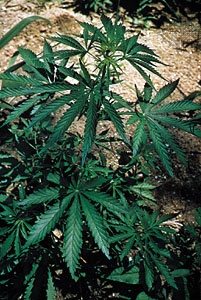hemp
plant
 (species Cannabis sativa), plant of the family Cannabaceae and its fibre, one of the bast fibre group. The plant is also grown for its seed, which contains about 30 percent oil, and for the drugs marijuana and hashish derived from its leaves and blossoms.
(species Cannabis sativa), plant of the family Cannabaceae and its fibre, one of the bast fibre group. The plant is also grown for its seed, which contains about 30 percent oil, and for the drugs marijuana and hashish derived from its leaves and blossoms.Hemp originated in Central Asia, and its cultivation for fibre, recorded in China as early as 2800 BC, was practiced in the Mediterranean countries of Europe early in the Christian era, spreading throughout the rest of Europe during the Middle Ages. In the New World it was planted in Chile in the 1500s and a century later in North America.
Hemp, growing in temperate zones, is an annual cultivated from seed, reaching a height of up to 16 feet (5 metres). Crops cultivated for fibre are densely sowed and produce plants averaging 6 to 10 feet (2 to 3 metres) tall with almost no branching. Plants grown for oilseed or drugs, planted farther apart, are shorter and many-branched. The slender stalks are hollow except at the tip and base. The leaves are compound with palmate shape, and the flowers are small and greenish yellow. Seed-producing flowers form elongate, spikelike clusters growing on the pistillate, or female, plants; pollen-producing flowers form many-branched clusters on staminate, or male, plants.
Crops grow best in sandy loam with good drainage and require average monthly rainfall of at least 2.5 inches (65 mm) throughout the growing season. Maximum yield and quality are obtained by harvesting soon after the plants reach maturity, indicated by the full blossoms and freely shedding pollen of the male plants. Although sometimes pulled up by hand, plants are more often cut off about an inch (2 to 3 cm) above the ground.
Fibres are obtained by subjecting the stalks to a series of operations—including retting, drying, and crushing—and a shaking process that completes separation from the woody portion, releasing the long, fairly straight fibre, or line. The fibre strands, usually over 5.8 feet (1.8 metres) long, are made of individual cylindrical cells with an irregular surface. The fibre, longer and less flexible than flax, is usually yellowish, greenish, or a dark brown or gray and, because it is not easily bleached to sufficiently light shades, is rarely dyed. It is strong and durable and is used for cordage—e.g., twine, yarn, rope, cable, and string—and for artificial sponges and such coarse fabrics as sacking (burlap) and canvas. In Italy some hemp receives special processing, producing whitish colour and attractive lustre, and is used to make fabric similar to linen. Other plant fibres used for cordage have been incorrectly called hemp, but only the hemp plant yields true hemp.
The oil obtained from hempseed can be used to make paints, varnishes, soaps, and edible oil; but the seed's chief commercial use has been for caged-bird feed. Hemp is grown primarily for fibre in most countries. Leading producers include India, Romania, China, Hungary, Poland, and Turkey. The largest of the importers are Italy, the United Kingdom, Belgium, Germany, and France.
- typhoid fever
- Typhoid Mary
- Typhon
- Typhoon
- typhoon
- typhus
- Typical capacities of urban mass transportation modes
- Typical density ranges for some other rock types
- Typical doses to exposed tissue received in routine X-ray diagnosis
- Typical magnetic fields
- Typical magnetic properties of rocks
- Typical resistivities
- Typical values of thermal conductivity
- typography
- typology
- Tyr
- Tyra Banks
- Tyrannius Rufinus
- tyrannosaur
- tyrannulet
- tyrant
- tyrant flycatcher
- Tyrconnell, Richard Talbot, Earl of, Viscount Baltinglass, Baron Of Talbotstown
- Tyrconnell, Rory O'Donnell, 1st Earl of, Baron Of Donegall
- Tyre